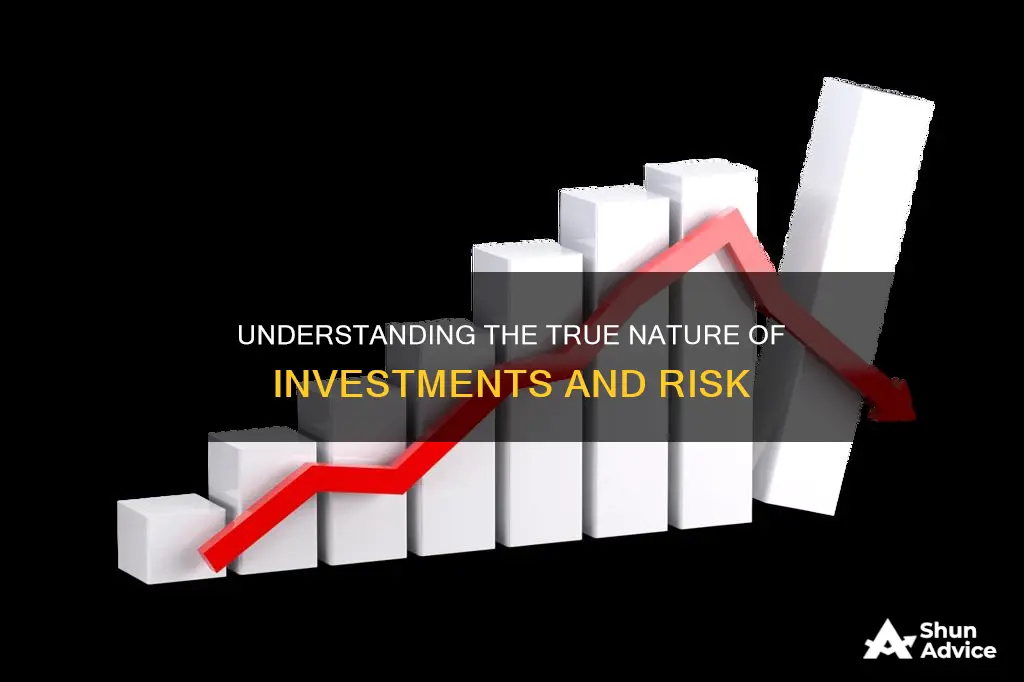
Risk is an inherent part of investing, and understanding the relationship between risk and investments is crucial for making informed financial decisions. Risk in the context of investing refers to the possibility of an investment performing below expectations or losing money. Every investment carries some level of risk, and it's important to recognise that higher potential returns often coincide with higher risks. This understanding is essential for investors to evaluate their risk tolerance and make choices that align with their financial goals and comfort level.
| Characteristics | Values |
|---|---|
| Risk involved in investments | Every investment carries some degree of risk |
| Risk and return relationship | Higher potential returns are associated with higher risks |
| Low-risk investments | Government bonds and savings accounts |
| High-risk investments | Stocks, options, and mutual funds |
| Safe investments | Treasury bills |
| Inflation risk | Reduction in purchasing power and investment returns |
| Interest rate risk | Bonds and other fixed-income investments are sensitive to interest rate changes |
| Economic downturns | Earnings capabilities of firms are threatened, especially large industrial firms |
| Market risk | Affects almost all types of investments, including stocks, bonds, and real estate |
| Company-specific or industry-specific events | Death of a company president, for example |
| Diversification | Can help reduce risk and manage specific risks |
| Risk profile considerations | Purpose of investment, timeframe, liquidity needs, and risk tolerance |
| Limiting risk exposure | Find a balance between risk and return, diversify investments |
What You'll Learn

Every investment carries some degree of risk
When it comes to investing, it's important to remember that every investment carries some degree of risk. This risk can manifest in various ways, and understanding these risks is crucial for making informed investment decisions.
Firstly, risk refers to the possibility of an investment not performing as expected. This could mean losing money, but it could also mean failing to keep up with inflation, resulting in a loss of purchasing power. For example, while low-risk investments like government bonds and savings accounts offer more peace of mind, they often provide lower returns that may not outpace inflation. On the other hand, high-risk investments like stocks can offer higher returns but also come with the risk of significant losses due to market fluctuations.
Additionally, market risk affects almost all types of investments. When the market experiences a downturn, it tends to pull down the values of most securities. Historical data shows that investing in stocks typically outperforms safer investments over the long term, but this doesn't eliminate the risk of short-term losses. Diversification can help mitigate this risk by spreading investments across different types of assets, reducing exposure to the performance of any single investment or market.
It's also essential to consider your risk tolerance and capacity. Risk tolerance refers to your emotional and mental ability to handle potential investment losses, while risk capacity is the amount of risk you can afford to take, based on factors like your financial situation and time horizon. Understanding your risk profile will help you determine the appropriate level of risk for your investments.
While investing does carry risk, it is still a powerful tool for building wealth. By understanding the different types of risks and carefully evaluating your risk profile, you can make more informed decisions about where and how to invest your money. Remember, the key is to find the right balance between risk and return, ensuring that you don't take on more risk than you are comfortable with or can afford.
NRI Investment: India or USA?
You may want to see also

Risk tolerance and capacity
When it comes to investing, risk is the possibility of your investments performing below your expectations or losing money. Risk tolerance and risk capacity are two crucial factors that influence an investor's decision-making process.
Risk tolerance refers to an investor's emotional and mental willingness to take on risk. It is shaped by an individual's beliefs, personality, and previous investment experience. A higher risk tolerance means that an investor is comfortable with market volatility and potential losses in pursuit of higher returns. On the other hand, a lower risk tolerance indicates a preference for more conservative investments that prioritise capital preservation over higher returns.
Risk capacity, on the other hand, is the amount of risk an investor can afford to take. This is determined by factors such as age, financial situation, income, and financial goals. For instance, an investor with a higher risk capacity may have a stable income, fewer financial obligations, and a longer time horizon to invest. Conversely, someone with a lower risk capacity may have immediate financial needs, higher expenses, or a shorter time frame to invest.
It's important to note that risk tolerance and risk capacity are not static and can change over time as an investor's circumstances evolve. For example, an investor's risk capacity may decrease as they approach retirement and have less time to recover from potential losses. Similarly, an investor's risk tolerance may fluctuate based on their current financial situation and comfort level with market volatility.
By assessing their risk tolerance and risk capacity, investors can make more informed decisions about the types of investments that align with their financial goals and comfort level with risk. It's crucial to find a balance between these two factors to ensure that the level of risk taken is appropriate for the investor's circumstances.
In conclusion, understanding one's risk tolerance and risk capacity is essential for making prudent investment choices. Investors should regularly evaluate these factors to ensure their investment strategies remain aligned with their financial objectives and risk appetite.
Private Equity Firm's Investment Realization: Strategy to Success
You may want to see also

Risk and return relationship
Risk and return are directly related. The higher the risk of an investment, the higher the potential for substantial returns. Conversely, investments with smaller risks are less likely to yield significant profits. This relationship is a fundamental investment principle that investors should understand to make informed decisions.
The risk-return trade-off is a critical concept in investing. It states that higher potential returns are linked to higher levels of uncertainty or risk. In other words, investors can only expect higher profits if they are willing to accept a greater possibility of losses. This trade-off depends on factors such as an investor's risk tolerance, years to retirement, and ability to replace lost funds.
Different types of investments carry varying degrees of risk. For instance, low-risk investments like government bonds and savings accounts typically offer lower returns, while high-risk investments like stocks or options can lead to significant gains but also come with a higher chance of loss.
It's important to note that diversifying one's investment portfolio can help mitigate risk without sacrificing potential returns. By spreading their assets across a range of investments, investors can balance risk and return, ensuring some investments have strong returns while others secure their principal.
Additionally, time plays a crucial role in the risk-return relationship. For example, investing in equities over the long term can provide the opportunity to recover from bear markets and participate in bull markets, reducing the overall risk. On the other hand, short-term equity investments carry a higher risk proposition.
Understanding the risk-return relationship is essential for investors to make informed decisions that align with their financial goals and risk tolerance.
John Hancock Investment Management Services LLC: Overview and Services
You may want to see also

Inflation risk
For example, if you buy a bond with a coupon rate of 3%, which is a normal amount, but the inflation rate is 2%, your purchasing power is only increasing by 1%. This is your real return. If the inflation rate climbs above 2%, it will erode the value of your bond even further. In a worst-case scenario, your real returns could become negative. For instance, if the nominal return is 3% but inflation is 5%, your real return would be -2%.
Several assets can be considered for protection against inflation risk, including index-linked bonds, real estate investment trusts (REITs), commodities, and well-balanced and diversified shares portfolios. Gold is also traditionally viewed as a hedge against inflation and tends to perform well during times of aggressive hikes.
Investment Bankers: Sales, Trading, and Equity Explained
You may want to see also

Diversification
The main idea behind diversification is to minimize the impact of any one particular risk. For example, if you invest all your money in one company and that company performs poorly, you could lose a significant portion of your investment. However, if you invest in multiple companies across different industries, the chances of all of them performing poorly at the same time are much lower.
It is important to note that while diversification can reduce risk, it does not completely eliminate it. It is still possible to experience losses in a diversified portfolio, especially if the overall market is performing poorly. However, diversification can help to smooth out investment returns over time and provide a more stable foundation for your investment portfolio.
Additionally, diversification should be viewed as a dynamic process rather than a one-time event. Regular rebalancing of your portfolio is important to ensure that it remains aligned with your investment goals and risk tolerance. Over time, some investments may grow faster than others, causing your portfolio to become unbalanced. By periodically reviewing and adjusting your investments, you can maintain the appropriate level of diversification for your needs.
Make Her Invest in You: Strategies for Deep Connection
You may want to see also
Frequently asked questions
Yes, all investments come with a level of risk and may not always perform as expected.
The higher the level of investment risk, the higher the potential return and the greater the danger of loss.
Risk is the likelihood of an investment not performing as expected, particularly if it loses money.
It's important to find a balance between risk and return. If you're seeking higher returns, you need to be willing to accept higher risks. Diversifying your investments can also help to reduce risk.







